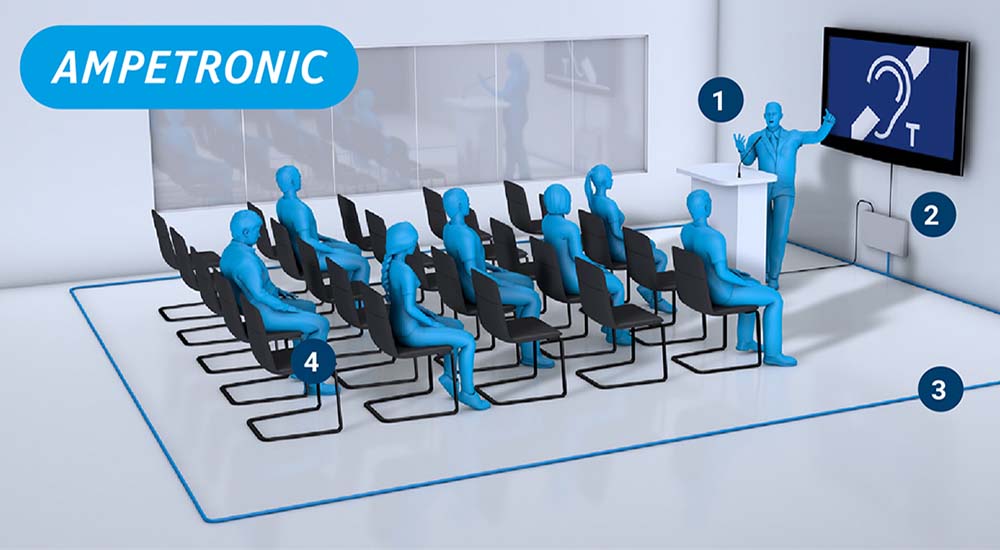Hearing Loop Maintenance Guidelines

There are three main components to a hearing loop (induction loop) system - 1) the audio source which is connected to the a/v components; 2) the hearing loop amplifier which is also connected to the a/v components; and 3) the hearing loop wire.
Why and how often do I need to maintain my hearing loop?
Considering that the acoustics of rooms change, buildings change, needs of users change and equipment can break; hearing loop systems should be regularly checked and monitored. Normally, an annual check should be sufficient and adding a standard check to your building/audio-visual equipment maintenance is essential. It is recommended that in academic spaces a check is made at the beginning of each semester.
Maintenance Check Essentials
There are a few essential elements/inspections that ensure the equipment is still working and providing value to your end users. The International Electrotechnical Commission (IEC) standard 60118-4 is a commonly referenced standard for hearing loop installations/maintenance. There are required areas for measurement, which include subjective tests (visual and audio inspections) and objective tests (field strength; frequency response; background noise).
The following links are examples of testing and certificates of conformity for hearing loops which walk you through these required areas of measurement.
Classroom/Large Area Examples:
- Ampetronic: Large Area Induction Loop Certificate of Test & Conformity
- Univox: Certificate of Conformity
Counter Loop Example:
Subjective Inspection
Visual Inspection
- Check for error lights. Check the front of the loop driver/amplifier and look for any red lights, error lights, or any other warning signs that would signify there might be an issue with the system.
- Check for pulled carpet or floor tile. Typically, the hearing loop wire is installed under carpet or floor tile but there are times when it is secured on top. Walk around the room, inspect the carpet and/or floor tile, and look for anything out of place (pulled carpet, turned up edges, wire exposure, etc.)
- Check for Signage. The international sign for hearing loop system is clearly visible and displayed to all users. For example, at the entrance to the looped room/s or on the counter.
Audio Inspection
- Play music and talk through the AV system. Play some music and talk through the system. Grab one of your loop listener/receivers and turn it on. Hold the loop listener/receiver vertical and listen for distortion, humming, popping, fizzing or intermittent signals.
- Turn off the loop driver and listen for humming. The next thing you can do is turn off the hearing loop driver completely and listen for humming. Many times, there is some background humming in rooms, and this is normal, but we want to make sure it is not an excess.
Objective Inspection
Using a Field Strength Meter (FSM), you will assess the background noise, field strength, and frequency response of the hearing loop.
Hold the device in a vertical position to align the telecoil with the component of the magnetic field you are testing. Measurements are made at multiple locations where listeners would be expected to be present during the event. Depending on the venue, measurements are made at 4 feet (1.2 meters) and/or 5.5 feet (1.7 meters) to simulate sitting and standing positions at each location.
- Background Noise
- Background noise is measured by the FSM. Background noise levels should be below -47dBA, but measures below -32dBA are acceptable. Counter loops and other transient environments allow for more noise but should be below -22dBA.
- Field Strength
- Using the FSM, confirm that the field strength does not deviate by more than ±3dB within the listening area.
- Frequency Response
- Using the FSM, confirm the frequency response is +/- 3 dB of the 1000 Hz measure to ensure consistent frequency response in areas critical to speech.
References
- Hearing Loop Maintenance - How to Service & Maintain Your Hearing Loop,
- Design Guide - Sound & Communications
- FSM Field Strength Meter - Williams AV
- Understanding Hearing Loops - Audiology Online
More Information:
-
- Much more information on hearing loop is available online. The linked page offers several key guidance pieces. If you have additional questions, send email to assistivelistening@virginia.edu
(last update 2/27/2023)
 Provost
Provost